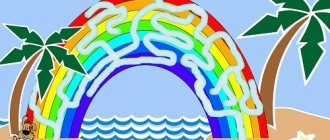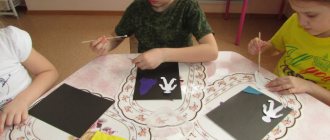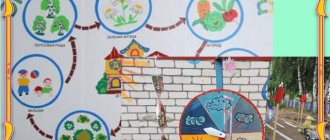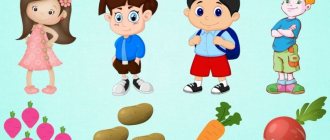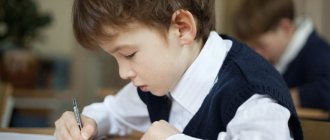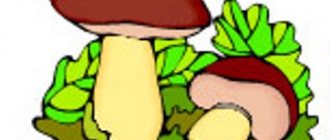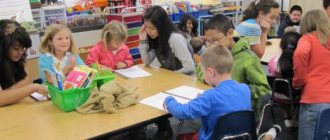Lesson for the senior group on the topic: “Travel into space”
Purpose: Familiarization with the planets of the solar system. Expanding knowledge and ideas about space and the profession of astronaut. Objectives: - Creating conditions for the formation of children’s elementary ideas about space. — Create a friendly atmosphere and positive emotions in children.
— Develop a sense of collectivism, the ability to play in groups.
— Improve the ability to establish the sequence of the day: morning, afternoon, evening, night. — Exercise the ability to move in a given direction (rotation, back and forth). Develop thinking. Expand words knowledge. Expand children's understanding of the planets of the solar system, the profession of astronaut, and the personal qualities of an astronaut. Develop cognitive interest, attention, memory, imagination, creativity. Equipment: projector and screen for presentation, flashlight, rocket model, solar system model, globe, hoop, yellow ball, small blue ball, water, solar system planet banner, “Starry Sky” night light, “Young Cosmonaut” emblems. Methods and techniques: gaming, visual, practical, verbal. Enrichment of vocabulary: cosmodrome, weightlessness, expedition, satellite, spacesuit, airship, airplane, planets of the solar system Health-saving technologies: relaxation break (imitation of sun rays), outdoor games. Surprise moment: The effect of the starry sky, interaction with teachers - they are in the role of aliens. Outdoor games “Weightlessness”, “Sunshine”, “Sun and Rain”. Presentation "Space Expedition".
Progress of the lesson:
Children to the song “Fly to the sun and return home quickly.” enter the hall.
Educator : Hello, guys. My name is Muminat Alibekovna. Look, guys, how many guests we have today. Are you happy to have guests? (Yes.) Then let's smile at them and welcome our dear guests. (Hello.) Guys, do you like to travel? (Yes.) Today we will go on an unusual space expedition and get acquainted with the planets of the solar system. Let's find out the sun moves around the earth or the earth around the sun. Why is there day and why is there night? And many, many interesting things. Let's sit down on the path. And before we go on Space Expedition, let's talk about space. What is space? (Children's answers.)
This is a starry sky. (Slide.) It is high, high. This is a system of planets. (Slide.) This is the moon with the earth. (Slide.) But this is the sun. (Slide.) Guys, tell me, is the sun a star or a planet? (Children’s answers. Slide.)
People have looked at the sky and dreamed of flying for a long time. First they flew in a hot air balloon, and then they flew in airships, in airplanes, then in airplanes and helicopters. But their dream did not leave them to rise even higher, into space. Then the first artificial satellite was launched into space. Please see what he looked like. Then a second space satellite was launched, but with a living creature. And who were these living beings? (Children's answers.) Why were dogs sent into space first? (Children's answers.) Look, guys. Slide
This is Belka and Strelka. Before they were sent into space, they were trained for a long, long time and they landed safely on the ground. Special spacesuits and helmets were made for them. Guys, what is a spacesuit? (Children's answers.) Slide.
But look what the spacesuit looks like? (Slide.)
Where do space rockets start from? (Children's answers.) Slide
Guys, a very, very long time ago, when not only your mothers and fathers were not yet, but your grandparents were not yet there, when your great-grandmothers and great-grandfathers were almost the same as you are now, the first person flew into space. Do you know who? (Children's answers.) Cosmonaut Yu. A. Gagarin. Please look at the screen.
In a space rocket called “Vostok” He was the first on the planet to rise to the stars.
He made one revolution around the earth. Spent 1 hour and 48 minutes in space.
And since then, on April 12, our country has been celebrating Cosmonautics Day.
What should an astronaut be like? (Children's answers.) Some of you too may become an astronaut. Girls can become astronauts too. Who knows the first woman astronaut? (Children's answers.) This is Valentina Tereshkova. (Slide.)
For what purpose does an astronaut fly into space? The astronaut is given a task and he completes it. And we have a task to learn about the planets of the solar system, how the Earth rotates. But before we go into space, I need to check your physical fitness. Don't yawn around - We are astronauts today! Let's start training to become strong and agile!
Exercise: “Swing-carousel and sat on a rocket”
To become an astronaut you need to train for a very long time, astronauts train on special simulators, and we train on a swing.
Children stand in a circle and begin to spin around themselves. - Swings, carousels, you and I sat on a rocket! Children go to the center of the circle and raise their hands up. Perform several times.
Educator: Well, now, guys, we can safely go on a flight in our spaceship, and you and I will fly into outer space. Well, where is our cosmodrome? Let's go guys.
The children enter the decoration ship and take their seats.
Educator: Fasten your seat belts. The devices were turned on. Let's start the countdown: 5,4,3,2,1 start!
Educator: Let's go! Slide video “Rocket flies into space” Look through your windows at the beauty of space!
Watching the film “Planets of the Solar System.” Educator: We are in outer space, I suggest you go into outer space.
Exercise: “Weightlessness.”
When you're in space, my friend. Miracles are happening all around. Look, this is news - After all, this is weightlessness.
(Children perform movements as if they are in zero gravity.)
Educator: Guys, look around, look. Someone is looking at us. Who is this? Yes, these are aliens. Let's say hello to them. Let's wave our hands at them.
And now guys, I invite you to the space laboratory. Guys, please look, these are the planets of the solar system. Please name which planets you remember. Try to find them here.
(Children name the planets they remember and show them. The teacher helps them if help is needed.)
Educator: Look, guys, in our universe, if we see such a sun, then the earth will be the size of this pea. Look how small she is. Take it, hold your planet in your hands. Pass it on to each other. Be careful not to drop it, because you are now holding our land in your hands.
Physical minute: In the morning the sun rises higher and higher, (stretch up). In the evening the sun sets lower and lower. (sit down)
(We repeat several times.) Educator: Guys, is this so? Let's check! Guys, sit down on the chairs. Guys, what is this? (Shows the globe.)
(Children's answers.) Correct. A globe is a model of the earth. The earth makes one revolution around its axis every 24 hours. And when the sun illuminates one side of the earth, it is day on that side. (We illuminate the globe with a flashlight.) And the next day it’s night. Day and night are days. What is a year? (Children's answers.) The earth makes one revolution around the sun in 365 days. This is the year. Earth's satellite is the Moon. The Moon is turned to the Earth on one side. It reflects the light of the sun, like a sunbeam. The Moon revolves around the Earth, and the Earth revolves around the Sun. Sometimes the Moon is not round, then it is called the Moon. To find out whether it is decreasing or increasing, you need to mentally insert a wand. If the letter P is increasing, if Y is decreasing. Teachers in the role of Aliens. Educator: Dear Aliens, do you agree with us? (They have eyes drawn on their hands and they seem to blink with them.)
Children in the role of the Earth and the Moon revolve around the sun.
Educator: Last July, an important cosmic event took place - a parade of planets. What is a parade? (Children answer.) ... people are walking, carrying banners, flags, balloons. And we will give our planets banners with numbers. (Children in the role of planets revolve around the sun, they have the number of the planet in their hands.) Educator: 1,2,3,4,5 - planets, stand in a row! Children line up in a row. Educator: Dear Aliens, do you like it? (Question to colleagues.) Well done guys! Guys, look, the sun without rays is not very beautiful. Let's turn into rays of sunshine ourselves. Lie down on the floor, hold hands. Feel each other's warmth. Raise your arms up, legs up, lie down, relax, and for now I’ll tell the sun about life on Earth. Close your eyes. The sun gives us such phenomena as sunset and sunrise. For us, sunrise is like the beginning of something new, and sunset is a wonderful phenomenon of beauty and mystery. On Earth we have rain (spray water on the children), and there is a light breeze (blow). Sunny, can you feel the touch of the rain and the breeze? (The children lie quietly, the “starry sky” lamp turns on, and the light turns off for a while.)
Open your eyes and admire space! (The lamp shines on the ceiling. Calm music plays.)
You see guys: the star has fallen. Make a wish.
Educator: guys, the time of our expedition is coming to an end.
Did you enjoy our expedition? (Children's answers.) Guys, it's time for us to return to earth. We take our seats in the spaceship.
So, countdown: 54321 launches!
The rocket returns to earth. The children leave the ship.
Educator: Guys, when astronauts return to earth after being in weightlessness for a long time, they even stop walking and they undergo a rehabilitation course and perform various exercises. Let's all stand in a circle and turn our backs to each other. Since we were also in zero gravity for a long time and have just returned from a flight, we will also do exercises. You draw on your friend’s back with your index finger what I will tell you. Draw a big sun with your finger. Guys, we will draw and walk slowly. The rays are leaving from the sun. The sun is shining. Suddenly a cloud appeared. It began to rain. Tap your finger on the back. The cloud appeared again. And the sun came out again. It shines brightly. Well done boys. So we completed the rehabilitation course. Guys, you liked the lesson. What did you like or remember most? (Children's answers.)
We all did a great job, and that’s why I’m awarding you the “Young Cosmonaut” medals. Thank you very much everyone.
Summary of a lesson on familiarization with the outside world in the senior group topic: “Cosmonautics Day”
"Cosmonautics Day"
in the senior group
Summary of a lesson on familiarization with the outside world in the senior group topic: “Cosmonautics Day”
Goals:
To form ideas about the holiday “Cosmonautics Day”, basic concepts about space, about the first flight into space. To consolidate the knowledge that the first cosmonaut was a citizen of Russia - Yuri Gagarin.
Tasks:
Educational:
Develop memory, speech, observation, logical thinking, interest in learning about the world around us.
Enrich children's vocabulary with new terms and concepts: weightlessness, spacesuit, cosmodrome, etc.
Educational:
Improve visual skills. Develop spatial imagination, fine and gross motor skills.
Educational:
To foster patriotic feelings and pride in the heroes of the pilots - the astronauts who conquered space. Instill a sense of pride in your country, a desire to be in some way like the heroic astronauts (play sports, do well in school in the future).
Equipment:
Illustrations on the topic (portraits of Yu. Gagarin, V. Tereshkova, A. Leonov; images of dogs - Belka and Strelka, Space rocket, spacesuit, cosmonaut in a state of weightlessness), equipment for drawing.
Progress of the lesson:
Let's start with the riddles:
- Planet blue,
Beloved, dear,
She's yours, she's mine,
And it’s called... (Earth).
- Lights the way at night,
Doesn't let the stars sleep
Let everyone sleep, she has no time for sleep,
He won’t fall asleep in the sky... (Moon).
- Peas are scattered across the dark sky
Colored caramel from sugar crumbs
And only when the morning comes,
All the caramel will suddenly melt. (stars)
- She spread her scarlet tail,
Flew off into a flock of stars.
Our people built this
Interplanetary... (rocket).
— Guys, guess what we’re going to talk about today? (about space, astronauts...)
-What holiday does our country celebrate on April 12? (Cosmonautics Day)
- Why is this holiday called that? (this is a holiday not only for astronauts, but also for those who participate in the development, construction and testing of space rockets, satellites, and all space technology).
Since ancient times, people have looked at the sky and thought about how to rise above the clouds and find out what is there. It took a long, long time before people learned to build aircraft. People wanted to know if there was life on other planets. And if there is, who lives there? Are these living creatures similar to people? But to find out about this, you need to fly to these planets. Airplanes were not suitable for this, because other stars and planets were very far away. And then scientists came up with rockets. (Show).
And the first to fly into them were not people, but animals: rats, and then dogs. Take a look at this picture. (Show). On it you can see the first dogs that flew into space and came back. Their names are Belka and Strelka. And only after the dogs successfully flew into space did the first man go there. Many years ago, on April 12, cosmonaut Yuri Gagarin flew into space. (Display of a portrait of Yuri Gagarin).
In a space rocket, With the name "Vostok"
He was the first on the planet to rise to the stars.
Since then, on this day every year we celebrate Cosmonautics Day - a holiday of astronauts and everyone who helps them fly successfully into space.
Gagarin underwent very good training.
-What do you think it takes to be an astronaut? (children's answers). That's right, because in order to be an astronaut you need to have good health, train a lot, and not be afraid of difficulties.
- Let us also go through space training.
Game "Cosmonauts" (speech with movement). We will try very hard, (children make jerks with their arms bent in front of their chest) Play sports together: Run fast, like the wind, (run on their tiptoes) Swim better than anyone in the world, (do strokes with their arms) Squat and get up again (squat) And lift dumbbells , (straighten bent arms up) Let's become strong, and tomorrow (hands on the belt) We will all be accepted as astronauts! (marching in place)
The astronaut is dressed in special clothes called a spacesuit (we show an illustration), on his head is a helmet where oxygen is supplied, because you and I know that there is no air in outer space, and he has heavy boots on his feet (after all, in space there is no gravity). —What is this state called in space? (state of weightlessness). This is a state when astronauts and things weigh nothing and swim in the spaceship like fish in an aquarium. There is no up or down. Spilled water does not spread into a puddle on the floor, but collects into a ball, and the ball hangs in the air. (Children depict different poses in a state of weightlessness) - Why do we say that an astronaut must be fearless?
Previously, people had never flown into space and did not know what they could encounter there. After all, there could be some malfunctions in the rocket. Therefore, astronauts must know very well how the rocket works in order to fix problems.
There should not be anything superfluous in the rocket, otherwise it will not take off or will not work as it should, and an overload will occur.
Let's play the game "Fourth Wheel"
Sun, sleep, sunny, sunshine.
Space, shaggy, astronaut, cosmic.
Planet, plan, planetary, planetarium
The return of the cosmonauts is awaited not only by their families, but also by the entire nation. And everyone rejoices when they land safely.
Therefore, when Yuri Gagarin flew into space for the first time, all our people followed this flight, everyone was worried about the first cosmonaut. And when he landed safely, the whole country rejoiced.
And after 2 years, a woman visited space - Valentina Vladimirovna Tereshkova (portrait showing). And 2 years later the first human spacewalk was made.
The first cosmonaut pilot to go into space was Alexey Leonov (portrait showing), he spent 10 minutes outside the ship and showed that it is possible to work in outer space.
— Guys, why do you think the work of astronauts is needed?
During the flight, astronauts see and observe a lot of interesting things and work a lot. They conduct medical and technical observations, study the surface of the Earth, report the approach of hurricanes and natural disasters, clarify the weather forecast, and conduct various experiments on the effects of weightlessness on different organisms. This is such a complex and interesting job.
Didactic game "Flight into space." What planet do we live on? What are the people on this planet called?
What does planet Earth look like from space? Who flies in space? (Cosmonauts, astronauts) Where do spaceships launch? (From the cosmodrome) What do they wear when they fly into space? (Helmet, spacesuit, special shoes) How much does an astronaut weigh in zero gravity? (Nothing).
Who was the first astronaut on Earth?
What holiday does our country celebrate on April 12?
Space is now not at all as mysterious as it seemed recently. And we, all the people of planet Earth, have great respect and admiration for Yuri Gagarin, the man with whom it all began, who was the first. And being first is always very difficult, guys! That is why it is his flight into space that we celebrate as a wonderful holiday - Cosmonautics Day.
Maybe one of you will also become an astronaut or a rocket designer and invent a rocket in which people will not experience the same overloads that astronauts are experiencing now. And glorify our Motherland.
Result:
— What new and interesting things did you learn today?
- What would you tell about at home, from what you saw and heard?
The lesson can end with a competition of children's drawings dedicated to space and astronautics.
